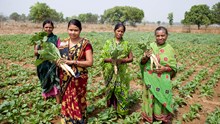
In India, goat farming has emerged as a rapidly growing and sustainable livelihood option for small and marginal farmers. With its low maintenance requirements, strong demand for meat and milk, and minimal investment, it is reshaping rural economies. Goats, often referred to as the "poor man's cow," are hardy animals capable of thriving in diverse climatic conditions with minimal food. They also need less space and begin producing returns within a year, making them an attractive option for farmers with limited land or capital.
According to the National Sample Survey Office (NSSO), goat meat consumption in India is increasing at a rate of approximately 6% annually. This growing demand, coupled with improved farming techniques and better breeds, is making goat farming a wise business choice for rural entrepreneurs.

Why Goat Farming is a Viable Option
Goat farming offers several benefits:
-
Low Maintenance: Goats require minimal space and fodder.
-
Hardy Animals: They can survive under varying climatic conditions.
-
Quick Returns: Goats start yielding returns within a year.
-
Financial Stability: Goat farming has supported thousands of families, whether they own a half-acre plot or are unemployed youths looking to start fresh.
However, the key to success in goat farming lies in choosing the right breed that aligns with your goals—whether it's for milk, meat, or breeding. Farmers must consider factors such as climate, available resources, and market demand when selecting a breed.
Top 10 Profitable Goat Breeds in India
1. Jamunapari
Native to Uttar Pradesh, the Jamunapari goat is known as the "queen of goats." These tall, majestic animals weigh 65 to 80 kg (for males) and have large, drooping ears. They are excellent for both meat and milk production, yielding 2 to 2.5 kg of milk per day. Due to their versatility, they are a popular choice for farmers.
2. Beetal
Originating from Punjab, the Beetal goat is another dual-purpose breed. Smaller than the Jamunapari, Beetal goats have black or reddish coats and long, drooping ears. A healthy Beetal doe gives 1 to 2 kg of milk daily. The breed matures quickly, making it ideal for those who want to sell goats for meat.
3. Osmanabadi
Indigenous to Maharashtra, the Osmanabadi goat is known for its hardiness and reproductive efficiency, often giving birth to twins. The breed yields about 3.5 kg of milk per day, making it an excellent choice for both milk and meat production.
4. Barbari
The Barbari goat is a prolific breeder found in Uttar Pradesh and Haryana. Though small in size, these goats have good-looking white coats with black patches. They provide 1 to 1.5 kg of milk per day and are known to give birth twice within 15 months, which helps in increasing herd size and revenue.
5. Tellicherry
Found in Kerala's hilly terrains, the Tellicherry goat is primarily raised for meat. These goats give approximately 1 to 1.5 kg of milk per day and are known for their flavorful meat, which fetches a good price in local markets.
6. Malabari
Also from Kerala, the Malabari goat is medium-sized, with males weighing around 40 kg and females 30 kg. Their milk production ranges from 0.9 to 2.8 kg per day. Adapted to Kerala's hot and humid climate, the Malabari goat is well-suited to local farmers.
7. Changthangi
Found in the cold mountains of Ladakh, the Changthangi goat is not primarily known for milk or meat but for its valuable pashmina wool. This high-quality fiber is used to produce some of the world's finest shawls, making the Changthangi goat a profitable breed for farmers in the region.
8. Surti
Native to Gujarat, the Surti goat is favored by dairy farmers for its ability to produce 2 to 3 liters of milk per day. Known for their calm temperament and good mothering instinct, Surti goats are ideal for farmers wishing to establish small-scale dairy farms.
9. Sangamneri
The Sangamneri goat from Maharashtra is known for its robustness. It is medium in size with coarse hair and light-colored coats. While its milk production may not be exceptional, this breed is known for its meat recovery and is easy to manage, especially in semi-arid climates.
10. Black Bengal
The Black Bengal goat, native to West Bengal and Bangladesh, is a small but highly prolific breed. They mature quickly and are in high demand for their tender meat. Despite their size, Black Bengal goats are an excellent option for farmers with limited land and resources due to their high reproductive rate and excellent meat quality.

Marketing and Income Opportunities
Goat farmers can generate income through various channels:
-
Live Goat Sales: Farmers can sell goats for breeding or meat.
-
Milk: Goats can be milked regularly for local consumption or for value-added products like ghee and cheese.
-
Manure: Goat manure is highly valued for its use in organic farming.
-
Value-Added Products: Beyond milk and meat, farmers can explore producing and selling products like goat cheese, ghee, and wool.
With the rise of digital platforms and goat fairs, farmers now have access to broader markets and can connect with potential buyers and breeders more easily.
Government Schemes and Support
Several government schemes are available to support goat farming:
-
National Livestock Mission (NLM): Provides financial support for goat housing, breeding improvements, and healthcare.
-
Rashtriya Krishi Vikas Yojana (RKVY): Offers assistance for fodder development, disease management, and farmer training.
-
NABARD Subsidies: Interest-subsidy loans for establishing commercial goat farms.
In addition to these, farmers can benefit from training programs, veterinary assistance, and breeding improvement centers in many states.
Goat farming has become a promising business for rural families due to the growing demand for meat, milk, and wool, along with advancements in farming techniques and government support. By choosing the right breed, providing proper care, and tapping into local markets, goat farming can ensure a steady income, whether you're raising a small herd or managing a large farm. It is more than just a business—goat farming provides a path toward financial independence and success for rural communities across India.
















